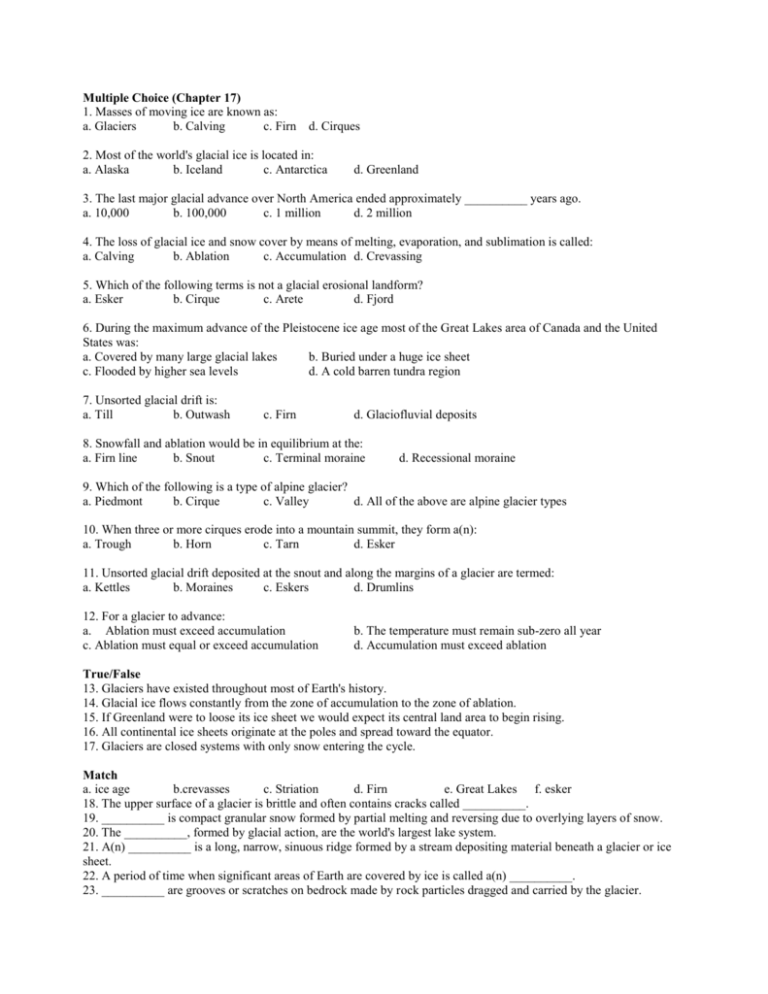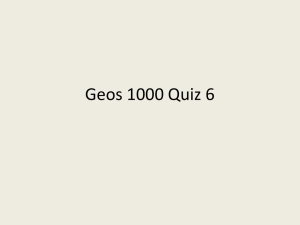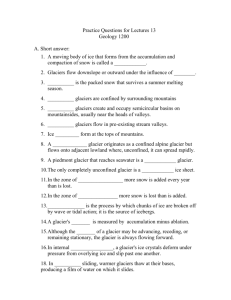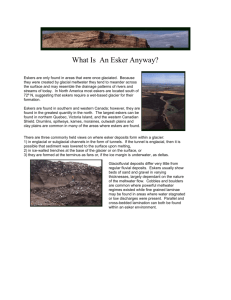Glaciers Test: Multiple Choice, True/False, Matching
advertisement

Multiple Choice (Chapter 17) 1. Masses of moving ice are known as: a. Glaciers b. Calving c. Firn d. Cirques 2. Most of the world's glacial ice is located in: a. Alaska b. Iceland c. Antarctica d. Greenland 3. The last major glacial advance over North America ended approximately __________ years ago. a. 10,000 b. 100,000 c. 1 million d. 2 million 4. The loss of glacial ice and snow cover by means of melting, evaporation, and sublimation is called: a. Calving b. Ablation c. Accumulation d. Crevassing 5. Which of the following terms is not a glacial erosional landform? a. Esker b. Cirque c. Arete d. Fjord 6. During the maximum advance of the Pleistocene ice age most of the Great Lakes area of Canada and the United States was: a. Covered by many large glacial lakes b. Buried under a huge ice sheet c. Flooded by higher sea levels d. A cold barren tundra region 7. Unsorted glacial drift is: a. Till b. Outwash c. Firn d. Glaciofluvial deposits 8. Snowfall and ablation would be in equilibrium at the: a. Firn line b. Snout c. Terminal moraine d. Recessional moraine 9. Which of the following is a type of alpine glacier? a. Piedmont b. Cirque c. Valley d. All of the above are alpine glacier types 10. When three or more cirques erode into a mountain summit, they form a(n): a. Trough b. Horn c. Tarn d. Esker 11. Unsorted glacial drift deposited at the snout and along the margins of a glacier are termed: a. Kettles b. Moraines c. Eskers d. Drumlins 12. For a glacier to advance: a. Ablation must exceed accumulation c. Ablation must equal or exceed accumulation b. The temperature must remain sub-zero all year d. Accumulation must exceed ablation True/False 13. Glaciers have existed throughout most of Earth's history. 14. Glacial ice flows constantly from the zone of accumulation to the zone of ablation. 15. If Greenland were to loose its ice sheet we would expect its central land area to begin rising. 16. All continental ice sheets originate at the poles and spread toward the equator. 17. Glaciers are closed systems with only snow entering the cycle. Match a. ice age b.crevasses c. Striation d. Firn e. Great Lakes f. esker 18. The upper surface of a glacier is brittle and often contains cracks called __________. 19. __________ is compact granular snow formed by partial melting and reversing due to overlying layers of snow. 20. The __________, formed by glacial action, are the world's largest lake system. 21. A(n) __________ is a long, narrow, sinuous ridge formed by a stream depositing material beneath a glacier or ice sheet. 22. A period of time when significant areas of Earth are covered by ice is called a(n) __________. 23. __________ are grooves or scratches on bedrock made by rock particles dragged and carried by the glacier. 1. a 2. c 3. a 4. b 5. a 6. b 7. a 8. a 9. d 10. b 11. b 12. d 13. f 14. t 15. t 16. t 17. f 18. b 19. d 20. e 21. f 22. a 23. c











